Keynote Review of Latest Advances in Thermoelectric Generation Materials, Devices, and Technologies 2022
Abstract
1. Introduction
2. Advances in Thermoelectric Materials and Methods
2.1. Recent Advancements in Thermoelectric Property Enhancement Principles
2.1.1. Power Factor Enhancement
2.1.2. Low Thermal Conductivity Principles
- Example of utilizing materials informatics to find low thermal conductivity compounds
- 2.
- Example of thermal conductivity reduction effect due to mixed anions
- 3.
- Lattice softening by doping
2.2. Several Notable Thermoelectric Material Systems
2.2.1. High, Mid-High Temperatures
2.2.2. Low Temperature Region
3. Advances in Thermoelectric Device Design and Fabrication
3.1. SKD-Based Thermoelectric Converters Development at NASA Jet Propulsion Laboratory
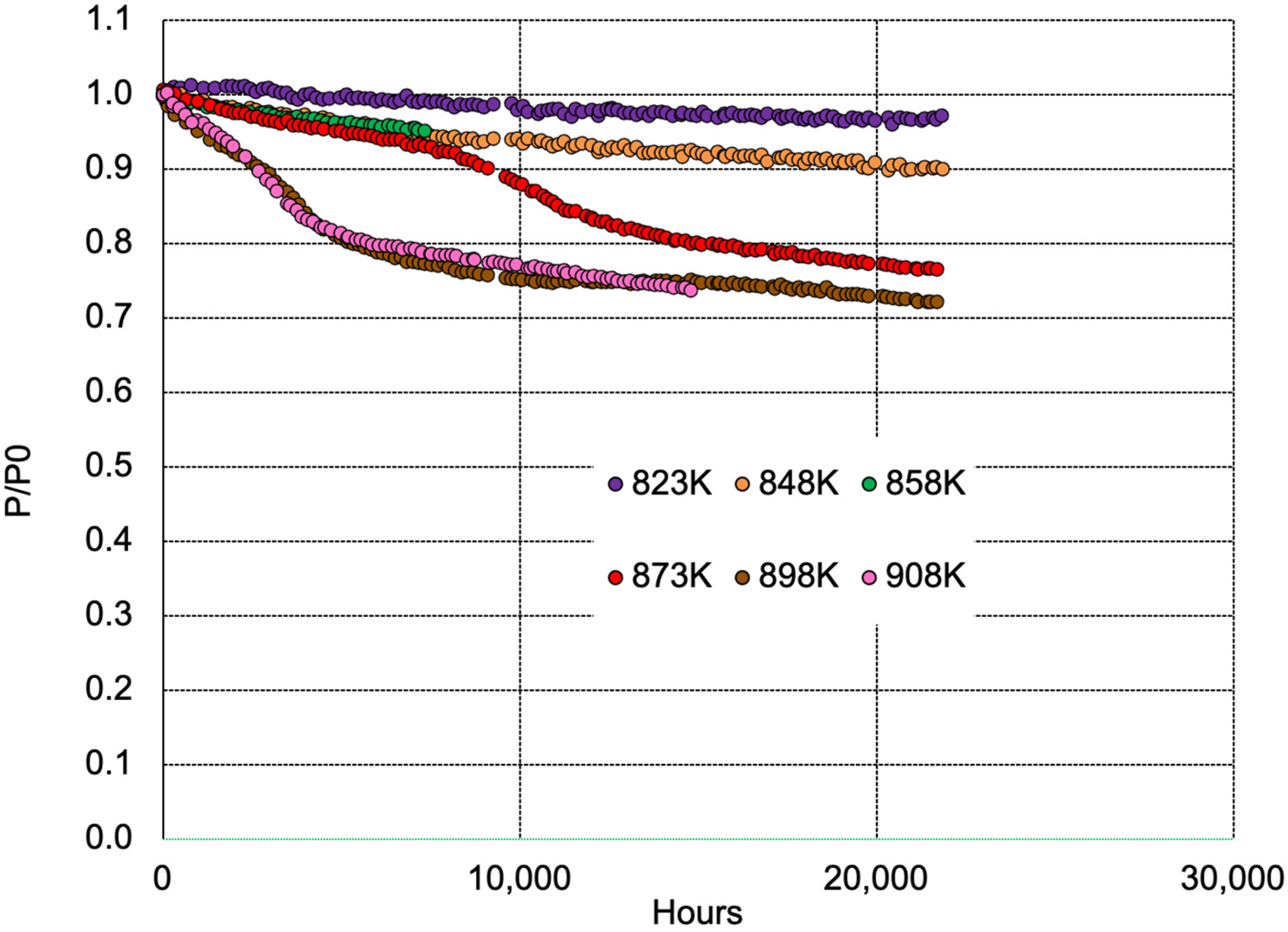
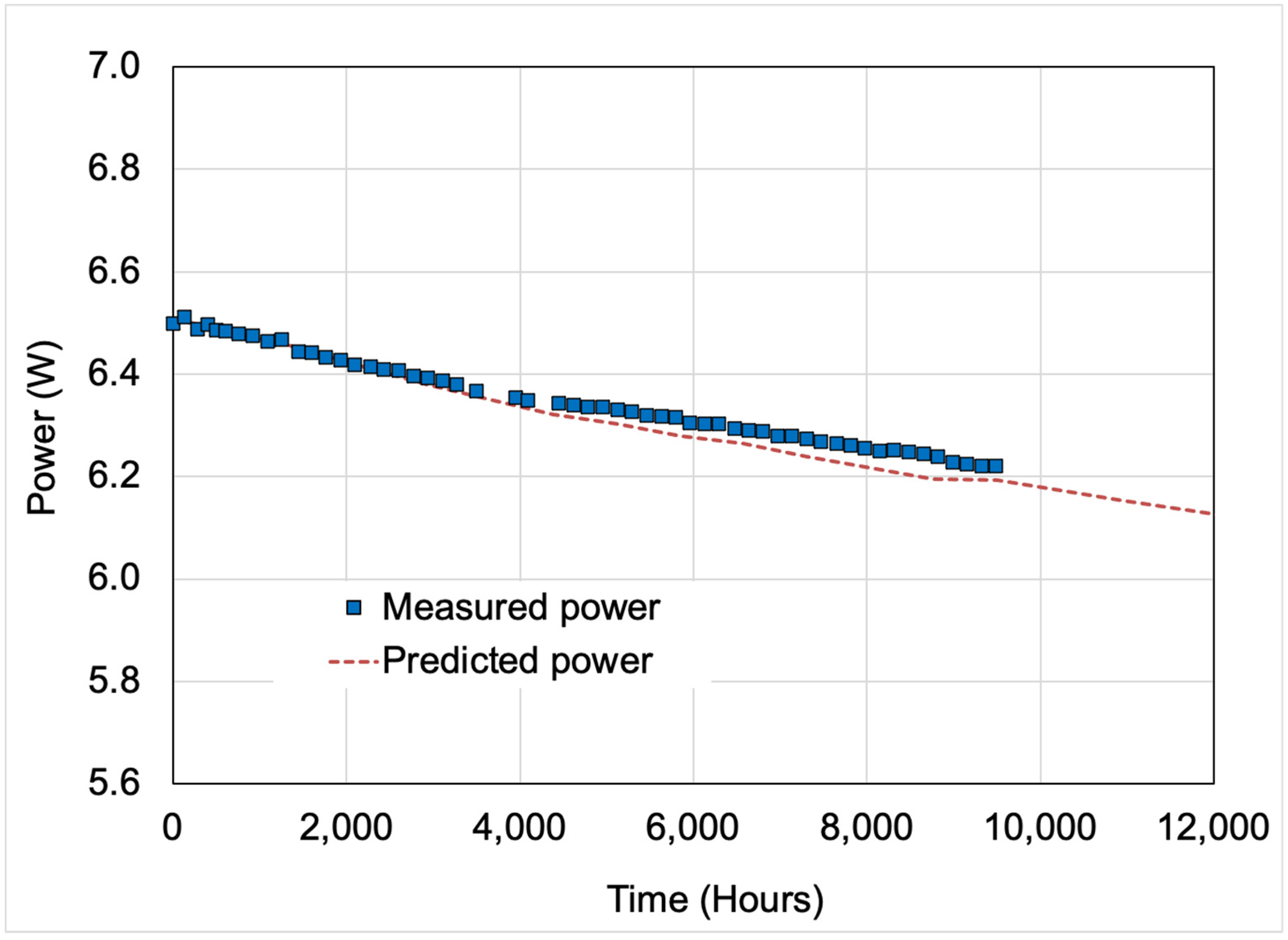
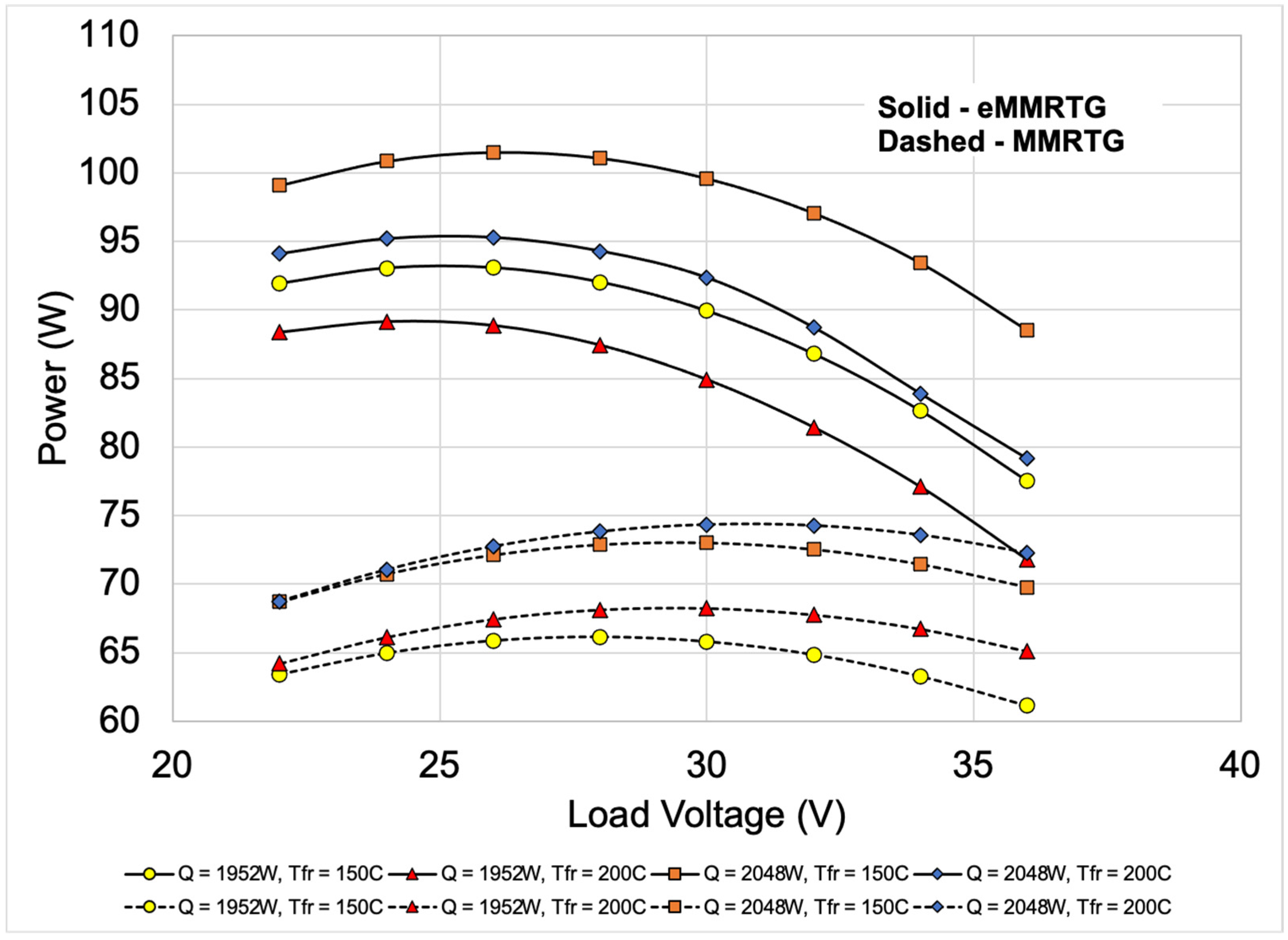
3.2. Low Temperature Module Directions
3.3. Module Fabrication of New Materials
4. Thermoelectric System Economics
- [κTE LTE/KH]—Non-dimensional parameter tied to TE Device/Heat Exchanger interfacial design parameters
- [Fopt AHEX/LTE2]—Non-dimensional parameter tied to TE device design
- where: [κTE LTE/KH]⋅[Fopt AHEX/LTE2 ] = [κTE Fopt AHEX/KH LTE] in first term on right-hand side of Equation (4)
- [CHEX UAU]/[(C‴ LTE/C″ + 1) C″ AHEX Fopt]—Non-dimensional parameter tied to the ratio of heat exchanger costs to TE device costs
- [κTE AHEX/(KH LTE)]—Non-dimensional parameter tied directly to interfacial heat flux
- 1/[(SpnΔT)2⋅σ⋅LTE]—Thermoelectric power factor tied directly to TE properties
4.1. Hot-Side Heat Flux Effects in TEG Cost-Performance Optimization
4.2. Thermal and Electrical Contact Resistance Effects on TEG Cost-Performance Optimization
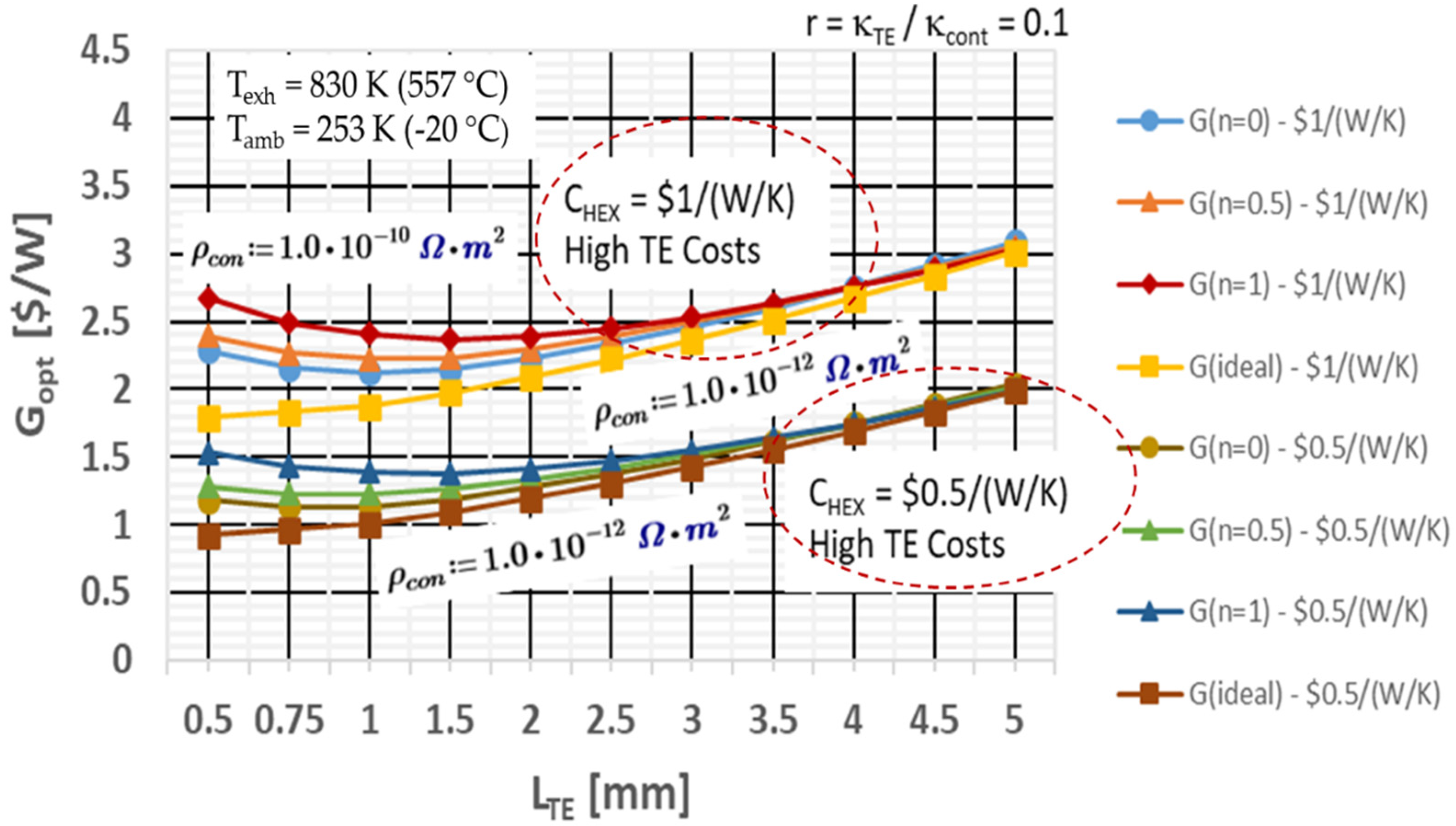
5. Conclusions
Author Contributions
Funding
Acknowledgments
Conflicts of Interest
Nomenclature
| English | |
| AHEX | TE/Heat Exchanger Interface Area [m2] |
| ATE | Thermoelectric Element Area [m2] |
| CTEG | Thermoelectric Generator Cost [$] |
| CHEX | Heat Exchanger Cost Parameter [$/(W/K)] |
| 𝐶′′ | TE System Manufacturing/Fabrication Costs per Area [$/m2] |
| 𝐶′′′ | TE Material Volumetric Costs per Volume [$/m3] |
| Cp | Exhaust Flow Specific Heat [J/kg-K] |
| fQ | Thermal Interface Function (Equation (2)) |
| F | Fill Factor |
| Fopt | Optimum Cost Fill Factor |
| G | Thermoelectric System Cost per Watt [$/W] |
| Gopt | Optimum Thermoelectric System Cost at Fopt [$/W] |
| I | Thermoelectric Device Current [A] |
| Kexh | Heat Exchanger Conductance [W/K] |
| KH | Hot Side Total Thermal Conductance [W/K] |
| KC | Cold Side Total Thermal Conductance [W/K] |
| KHX | Heat Exchanger Conductance Value [W/K] |
| KTE | Effective Thermoelectric Conductance [W/K] |
| lc | Thickness of thermal contact layer [m] |
| L | Thermoelectric Element Length [m] |
| m | Load resistance to TE device resistance ratio |
| Exhaust mass flow rate [kg/sec] | |
| N | Number of Thermoelectric Couples |
| n | Cost influence factor in Equation (4–5) |
| q | Thermal Flux [W/m2] |
| Q | Thermal Transfer on Hot- or Cold-Side [W] |
| r | Thermal Interface Contact Parameter—Thermal Conductivity Ratio [κTE/κcon] |
| Spn | Total Seebeck Coefficient (= Sp + |Sn|) [V/K] |
| UAu | Heat Exchanger UA Value [W/K] |
| V | Thermoelectric Device Voltage [V] |
| T | Temperature [K] |
| ZT | Figure of merit (dimensionless) |
| ZTav | Average Figure of merit (dimensionless) |
| Greek | |
| ΔT | (Texh − Tamb) [K] |
| ε | Heat Exchanger Thermal Effectiveness |
| γ | Thermoelectric Element Length to Area Ratio [m−1] |
| κ | Thermal Conductivity (thermoelectric material unless otherwise specified) [W/m/K] |
| η | Thermoelectric Conversion Efficiency |
| ρcon | Electrical Contact Resistivity [Ohm − m2] |
| ρave | Average Electrical Resistivity of p-type and n-type TE materials [Ohm − m] |
| σ | Electrical Conductivity [S/m] |
| Subscripts | |
| amb | ambient environment |
| con | contact interface |
| exh | exhaust conditions |
| h or H | Associated with TE hot-side parameter |
| c or C | Associated with TE cold-side parameter |
| n | Associated with TE n-type materials |
| p | Associated with TE p-type materials |
| TE | Thermoelectric parameter |
| HEX | Heat Exchanger parameter |
References
- Bell, L.E. Cooling, heating, generating power, and recovering waste heat with thermoelectric systems. Science 2008, 321, 1457–1461. [Google Scholar] [CrossRef] [PubMed]
- Mori, T.; Priya, S. Materials for energy harvesting: At the forefront of a new wave. MRS Bull. 2018, 43, 176–180. [Google Scholar] [CrossRef]
- Champier, D. Thermoelectric generators: A review of applications. Energy Convers. Manag. 2017, 140, 167–181. [Google Scholar] [CrossRef]
- Tan, G.; Ohta, M.; Kanatzidis, M.G. Thermoelectric power generation: From new materials to devices. Philos. Trans. R. Soc. A 2019, 377, 20180450. [Google Scholar] [CrossRef] [PubMed]
- Mori, T. Perspectives of high-temperature thermoelectric applications and p-type and n-type aluminoborides. JOM 2016, 68, 2673–2679. [Google Scholar] [CrossRef]
- Hendricks, T.J. Thermoelectric system economics: Where the laws of thermoelectrics, thermodynamics, heat transfer and economics intersect. MRS Adv. 2019, 4, 457–471. [Google Scholar] [CrossRef]
- Hendricks, T.J. New paradigms in defining optimum cost conditions in thermoelectric energy recovery designs. Mater. Today Proc. 2019, 8, 613–624. [Google Scholar] [CrossRef]
- Miller, E.W.; Hendricks, T.J.; Wang, H.; Peterson, R.B. Integrated dual-cycle energy recovery using thermoelectric conversion and an organic rankine bottoming cycle. Proc. Inst. Mech. Eng. Part A J. Power Energy 2011, 225, 33–43. [Google Scholar] [CrossRef]
- Wang, H.; Hendricks, T.; Krishnan, S. Experimental validation of a portable power and cooling system using integrated TEG-ORC. J. Thermophys Heat Transf. 2021, 35, 411–420. [Google Scholar] [CrossRef]
- Petsagkourakis, I.; Tybrandt, K.; Crispin, X.; Ohkubo, I.; Satoh, N.; Mori, T. Thermoelectric taterials and applications for energy harvesting power generation. Sci. Technol. Adv. Mater. 2018, 19, 836–862. [Google Scholar] [CrossRef] [PubMed]
- Haras, M.; Skotnicki, T. Thermoelectricity for IoT—A review. Nano Energy 2018, 54, 461–476. [Google Scholar] [CrossRef]
- Tarancón, A. Powering the IoT revolution with heat. Nat. Electron. 2019, 2, 270–271. [Google Scholar] [CrossRef]
- Nandihalli, N.; Liu, C.-J.; Mori, T. Polymer based thermoelectric nanocomposite materials and devices: Fabrication and characteristics. Nano Energy 2020, 78, 105186. [Google Scholar] [CrossRef]
- Soleimani, Z.; Zoras, S.; Ceranic, B.; Cui, Y.; Shahzad, S. A comprehensive review on the output voltage/power of wearable thermoelectric generators concerning their geometry and thermoelectric materials. Nano Energy 2021, 89, 106325. [Google Scholar] [CrossRef]
- Sootsman, J.; Young Chung, D.; Kanatzidis, M.G. New and old concepts in thermoelectric aaterials. Angew. Chem. Int. Ed. 2009, 48, 8616–8639. [Google Scholar] [CrossRef]
- He, J.; Tritt, T.M. Advances in thermoelectric materials research: Looking back and moving forward. Science 2017, 357, eaak9997. [Google Scholar] [CrossRef] [PubMed]
- Zhu, T.; Liu, Y.; Fu, C.; Heremans, J.P.; Snyder, J.G.; Zhao, X. Compromise and synergy in high-efficiency thermoelectric materials. Adv. Mater. 2017, 29, 1605884. [Google Scholar] [CrossRef] [PubMed]
- Mori, T. Novel principles and nanostructuring methods for enhanced thermoelectrics. Small 2017, 13, 1702013. [Google Scholar] [CrossRef] [PubMed]
- Mao, J.; Liu, Z.; Zhou, J.; Zhu, H.; Zhang, Q.; Chen, G.; Ren, Z. Advances in thermoelectrics. Adv. Phys. 2018, 67, 69–147. [Google Scholar] [CrossRef]
- Garmroudi, F.; Riss, A.; Parzer, M.; Reumann, N.; Müller, H.; Bauer, E.; Khmelevskyi, S.; Podloucky, R.; Mori, T.; Tobita, K.; et al. Boosting the thermoelectric performance of Fe2VAl−type Heusler compounds by band engineering. Phys. Rev. B Condens. Matter 2021, 103, 085202. [Google Scholar] [CrossRef]
- Fu, C.; Zhu, T.; Liu, Y.; Xie, H.; Zhao, X. Band engineering of high performance p-type FeNbSb based half-heusler thermoelectric materials for figure of merit ZT > 1. Energy Environ. Sci. 2015, 8, 216–220. [Google Scholar] [CrossRef]
- Heremans, J.P.; Jovovic, V.; Toberer, E.S.; Saramat, A.; Kurosaki, K.; Charoenphakdee, A.; Yamanaka, S.; Snyder, G.J. Enhancement of thermoelectric efficiency in PbTe by distortion of the electronic density of states. Science 2008, 321, 554–557. [Google Scholar] [CrossRef] [PubMed]
- Pei, Y.; Shi, X.; LaLonde, A.; Wang, H.; Chen, L.; Snyder, G.J. Convergence of electronic bands for high performance bulk thermoelectrics. Nature 2011, 473, 66–69. [Google Scholar] [CrossRef] [PubMed]
- Wang, H.; Pei, Y.; LaLonde, A.D.; Snyder, G.J. Material design considerations based on thermoelectric quality factor. In Thermoelectric Nanomaterials; Koumoto, K., Mori, T., Eds.; Springer: Berlin/Heidelberg, Germany, 2013; pp. 3–32. [Google Scholar]
- Shakouri, A.; LaBounty, C.; Abraham, P.; Piprek, J.; Bowers, J.E. Enhanced thermionic emission cooling in high barrier superlattice heterostructures. MRS Proc. 1998, 545. [Google Scholar] [CrossRef]
- Bailyn, M. Maximum variational principle for conduction problems in a magnetic field, and the theory of magnon drag. Phys. Rev. 1962, 126, 2040–2054. [Google Scholar] [CrossRef]
- Bailyn, M. Transport in Metals: Effect of the Nonequilibrium Phonons. Phys. Rev. 1958, 112, 1587–1598. [Google Scholar] [CrossRef]
- Klemens, P.G. The contribution of phonons to the thomson coefficient. Aust. J. Phys. 1954, 7, 520. [Google Scholar] [CrossRef]
- Ang, R.; Khan, A.U.; Tsujii, N.; Takai, K.; Nakamura, R.; Mori, T. Thermoelectricity generation and electron–magnon scattering in a natural chalcopyrite mineral from a deep-sea hydrothermal vent. Angew. Chem. Int. Ed. 2015, 54, 12909–12913. [Google Scholar] [CrossRef] [PubMed]
- Matsuura, H.; Ogata, M.; Mori, T.; Bauer, E. Theory of huge thermoelectric effect based on a magnon drag mechanism: Application to thin-film heusler alloy. Phys. Rev. B Condens. Matter 2021, 104, 214421. [Google Scholar] [CrossRef]
- Ahmed, F.; Tsujii, N.; Mori, T. Thermoelectric properties of CuGa1−xMnxTe2: Power factor enhancement by incorporation of magnetic ions. J. Mater. Chem. A 2017, 5, 7545–7554. [Google Scholar] [CrossRef]
- Zheng, Y.; Lu, T.; Polash, M.M.H.; Rasoulianboroujeni, M.; Liu, N.; Manley, M.E.; Deng, Y.; Sun, P.J.; Chen, X.L.; Hermann, R.P.; et al. Paramagnon drag in high thermoelectric figure of merit Li-doped MnTe. Sci. Adv. 2019, 5, eaat9461. [Google Scholar] [CrossRef] [PubMed]
- Vaney, J.-B.; Yamini, S.A.; Takaki, H.; Kobayashi, K.; Kobayashi, N.; Mori, T. Magnetism-mediated thermoelectric performance of the Cr-doped bismuth telluride tetradymite. Mater. Today Phys. 2019, 9, 100090. [Google Scholar] [CrossRef]
- Tsujii, N.; Nishide, A.; Hayakawa, J.; Mori, T. Observation of enhanced thermopower due to spin fluctuation in weak itinerant ferromagnet. Sci. Adv. 2019, 5, eaat5935. [Google Scholar] [CrossRef]
- Zhao, W.; Liu, Z.; Sun, Z.; Zhang, Q.; Wei, P.; Mu, X.; Zhou, H.; Li, C.; Ma, S.; He, D.; et al. Superparamagnetic enhancement of thermoelectric performance. Nature 2017, 549, 247–251. [Google Scholar] [CrossRef] [PubMed]
- Zhao, W.; Liu, Z.; Wei, P.; Zhang, Q.; Zhu, W.; Su, X.; Tang, X.; Yang, J.; Liu, Y.; Shi, J.; et al. Magnetoelectric interaction and transport behaviours in magnetic nanocomposite thermoelectric materials. Nat. Nanotechnol. 2016, 12, 55–60. [Google Scholar] [CrossRef] [PubMed]
- Du, B.; Lai, X.; Liu, Q.; Liu, H.; Wu, J.; Liu, J.; Zhang, Z.; Pei, Y.; Zhao, H.; Jian, J. Spark plasma sintered bulk nanocomposites of Bi2Te2.7Se0.3 nanoplates incorporated Ni nanoparticles with enhanced thermoelectric performance. ACS Appl. Mater. Interfaces 2019, 11, 31816–31823. [Google Scholar] [CrossRef]
- Pei, J.; Dong, J.; Cai, B.; Zhang, Y.; Zhou, W.; Zhang, B.-P.; Ge, Z.-H.; Li, J.-F. Weak-ferromagnetism for room temperature thermoelectric performance enhancement in p-Type (Bi,Sb)2Te3. Mater. Today Phys. 2021, 19, 100423. [Google Scholar] [CrossRef]
- Terasaki, I.; Sasago, Y.; Uchinokura, K. Large thermoelectric power in NaCo2O4 single crystals. Phys. Rev. B Condens. Matter. 1997, 56, R12685–R12687. [Google Scholar] [CrossRef]
- Koshibae, W.; Tsutsui, K.; Maekawa, S. Thermopower in cobalt oxides. Phys. Rev. B Condens. Matter 2000, 62, 6869–6872. [Google Scholar] [CrossRef]
- Sussardi, A.; Tanaka, T.; Khan, A.U.; Schlapbach, L.; Mori, T. Enhanced thermoelectric Properties of samarium boride. J. Mater. 2015, 1, 196–204. [Google Scholar] [CrossRef]
- Hébert, S.; Daou, R.; Maignan, A.; Das, S.; Banerjee, A.; Klein, Y.; Bourgès, C.; Tsujii, N.; Mori, T. Thermoelectric materials taking advantage of spin entropy: Lessons from chalcogenides and oxides. Sci. Technol. Adv. Mater. 2021, 22, 583–596. [Google Scholar] [CrossRef] [PubMed]
- Acharya, S.; Anwar, S.; Mori, T.; Soni, A. Coupling of charge carriers with magnetic entropy for power factor enhancement in Mn doped Sn1.03Te for thermoelectric applications. J. Mater. Chem. C 2018, 6, 6489–6493. [Google Scholar] [CrossRef]
- Chang, H.; Gui, X.; Huang, S.; Nepal, R.; Chapai, R.; Xing, L.; Xie, W.; Jin, R. Mn-induced ferromagnetism and enhanced thermoelectric properties in Ru1−xMnxSb2+δ. New J. Phys. 2019, 21, 033008. [Google Scholar] [CrossRef]
- Li, C.; Ma, S.; Wei, P.; Zhu, W.; Nie, X.; Sang, X.; Sun, Z.; Zhang, Q.; Zhao, W. Magnetism-induced huge enhancement of the room-temperature thermoelectric and cooling performance of p-type BiSbTe alloys. Energy Environ. Sci. 2020, 13, 535–544. [Google Scholar] [CrossRef]
- Fortulan, R.; Yamini, S.A.; Nwanebu, C.; Li, S.; Baba, T.; Reece, M.J.; Mori, T. Thermoelectric performance of n-type magnetic element doped Bi2S3. ACS Appl. Energy Mater. 2022, 5, 3845–3853. [Google Scholar] [CrossRef]
- Khan, A.U.; Orabi, R.A.R.A.; Pakdel, A.; Vaney, J.-B.; Fontaine, B.; Gautier, R.; Halet, J.-F.; Mitani, S.; Mori, T. Sb Doping of metallic CuCr2S4 as a route to highly improved thermoelectric properties. Chem. Mater. 2017, 29, 2988–2996. [Google Scholar] [CrossRef]
- Shuai, J.; Mao, J.; Song, S.; Zhu, Q.; Sun, J.; Wang, Y.; He, R.; Zhou, J.; Chen, G.; Singh, D.J.; et al. Tuning the carrier scattering mechanism to effectively improve the thermoelectric properties. Energy Environ. Sci. 2017, 10, 799–807. [Google Scholar] [CrossRef]
- Wang, H.; Gurunathan, R.; Fu, C.; Cui, R.; Zhu, T.; Snyder, G.J. Thermoelectric transport effects beyond single parabolic band and acoustic phonon scattering. Mater. Adv. 2022, 3, 734–755. [Google Scholar] [CrossRef]
- Hu, C.; Xia, K.; Fu, C.; Zhao, X.; Zhu, T. Carrier grain boundary scattering in thermoelectric materials. Energy Environ. Sci. 2022, 15, 1406–1422. [Google Scholar] [CrossRef]
- Mori, T.; Hara, T. Hybrid effect to possibly overcome the trade-off between seebeck coefficient and electrical conductivity. Scr. Mater. 2016, 111, 44–48. [Google Scholar] [CrossRef]
- Zianni, X. The Annealed-Nanograin Phase: A route to simultaneous increase of the conductivity and the seebeck coefficient and high thermoelectric performance. J. Appl. Phys. 2019, 126, 194301. [Google Scholar] [CrossRef]
- Hsu, K.F.; Loo, S.; Guo, F.; Chen, W.; Dyck, J.S.; Uher, C.; Hogan, T.; Polychroniadis, E.K.; Kanatzidis, M.G. Cubic AgPbmSbTe2+m: Bulk thermoelectric materials with high figure of merit. Science 2004, 303, 818–821. [Google Scholar] [CrossRef] [PubMed]
- Sootsman, J.; Kong, H.; Uher, C.; Downey, A.; D’Angelo, J.J.; Wu, C.I.; Hogan, T.; Caillat, T.; Kanatzidis, M. Transport Behavior and Thermal Conductivity Reduction in the Composite System PbTe-Pb-Sb; Thermoelectric Power Generation: Boston, MA, USA, 2008; Volume 1044. [Google Scholar]
- Wang, X.W.; Lee, H.; Lan, Y.C.; Zhu, G.H.; Joshi, G.; Wang, D.Z.; Yang, J.; Muto, A.J.; Tang, M.Y.; Klatsky, J.; et al. Enhanced thermoelectric figure of merit in nanostructured n-type silicon germanium bulk alloy. Appl. Phys. Lett. 2008, 93, 193121. [Google Scholar] [CrossRef]
- Liu, Z.; Mao, J.; Liu, T.-H.; Chen, G.; Ren, Z. Nano-microstructural control of phonon engineering for thermoelectric energy harvesting. MRS Bull. 2018, 43, 181–186. [Google Scholar] [CrossRef]
- Liu, Z.; Mori, T. Nanostructured bulk thermoelectric materials for energy harvesting. In System-Materials Nanoarchitectonics; Wakayama, Y., Ariga, K., Eds.; Springer: Tokyo, Japan, 2022; pp. 199–231. [Google Scholar]
- Gaultois, M.W.; Oliynyk, A.O.; Mar, A.; Sparks, T.D.; Mulholland, G.J.; Meredig, B. Perspective: Web-based machine learning models for real-time screening of thermoelectric materials properties. APL Mater. 2016, 4, 053213. [Google Scholar] [CrossRef]
- Zhang, R.; Chen, K.; Du, B.; Reece, M.J. Screening for Cu–S based thermoelectric materials using crystal structure features. J. Mater. Chem. A 2017, 5, 5013–5019. [Google Scholar] [CrossRef]
- Suwardi, A.; Bash, D.; Ng, H.K.; Gomez, J.R.; Repaka, D.V.M.; Kumar, P.; Hippalgaonkar, K. Inertial effective mass as an effective descriptor for thermoelectrics via data-driven evaluation. J. Mater. Chem. A 2019, 7, 23762–23769. [Google Scholar] [CrossRef]
- Li, M.; Cao, G.; Luo, Y.; Sheng, C.; Liu, H. Predicting the lattice thermal conductivity of alloyed compounds from the perspective of configurational Entropy. NPJ Comput. Mater. 2022, 8, 75. [Google Scholar] [CrossRef]
- Liu, Z.; Zhang, W.; Gao, W.; Mori, T. A material catalogue with glass-like thermal conductivity mediated by crystallographic occupancy for thermoelectric application. Energy Environ. Sci. 2021, 14, 3579–3587. [Google Scholar] [CrossRef]
- Pal, K.; He, J.; Wolverton, C. Bonding hierarchy gives rise to high thermoelectric performance in layered Zintl compound BaAu2P4. Chem. Mater. 2018, 30, 7760–7768. [Google Scholar] [CrossRef]
- Dutta, M.; Samanta, M.; Ghosh, T.; Voneshen, D.J.; Biswas, K. Evidence of highly anharmonic soft lattice vibrations in a Zintl rattler. Angew. Chem. Int. Ed. 2020, 60, 4259–4265. [Google Scholar] [CrossRef]
- Pandey, T.; Nissimagoudar, A.S.; Mishra, A.; Singh, A.K. Ultralow thermal conductivity and high thermoelectric figure of merit in mixed valence In5X5Br (X = S, and Se) compounds. J. Mater. Chem. A 2020, 8, 13812–13819. [Google Scholar] [CrossRef]
- Shen, Y.; Wang, F.Q.; Wang, Q. Ultralow thermal conductivity and negative thermal expansion of CuSCN. Nano Energy 2020, 73, 104822. [Google Scholar] [CrossRef]
- Sato, N.; Kuroda, N.; Nakamura, S.; Katsura, Y.; Kanazawa, I.; Kimura, K.; Mori, T. Bonding heterogeneity in mixed-anion compounds realizes ultralow lattice thermal conductivity. J. Mater. Chem. A 2021, 9, 22660–22669. [Google Scholar] [CrossRef]
- Barreteau, C.; Bérardan, D.; Amzallag, E.; Zhao, L.; Dragoe, N. Structural and electronic transport properties in Sr-doped BiCuSeO. Chem. Mater. 2012, 24, 3168–3178. [Google Scholar] [CrossRef]
- Pei, Y.-L.; He, J.; Li, J.-F.; Li, F.; Liu, Q.; Pan, W.; Barreteau, C.; Berardan, D.; Dragoe, N.; Zhao, L.-D. High thermoelectric performance of oxyselenides: Intrinsically low thermal conductivity of Ca-doped BiCuSeO. NPG Asia Mater. 2013, 5, e47. [Google Scholar] [CrossRef]
- Muchtar, A.R.; Srinivasan, B.; Tonquesse, S.L.; Singh, S.; Soelami, N.; Yuliarto, B.; Berthebaud, D.; Mori, T. Physical insights on the lattice softening driven mid-temperature range thermoelectrics of Ti/Zr-inserted SnTe—an outlook beyond the horizons of conventional phonon scattering and excavation of Heikes’ equation for estimating carrier properties. Adv. Energy Mater. 2021, 11, 2101122. [Google Scholar] [CrossRef]
- Liu, Y.; Zhou, M.; He, J. Towards higher thermoelectric performance of Bi2Te3 via defect engineering. Scr. Mater. 2016, 111, 39–43. [Google Scholar] [CrossRef]
- Uher, C. Thermoelectric properties of Skutterudites. In Thermoelectric Skutterudites; CRC Press: Boca Raton, FL, USA, 2021; pp. 261–318. [Google Scholar]
- Jovovic, V. Thermoelectric Waste Heat Recovery Program for Passenger Vehicles; Technique Report for Gentherm Incorporated; Gentherm Incorporated: Azusa, CA, USA, 2014. [Google Scholar]
- Salvador, J. Development of Cost-Competitive Advanced Thermoelectric Generators for Direct Conversion of Vehicle Waste Heat into Useful Electrical Power; Technique Report for General Motors LLC; General Motors LLC: Warrenton, VA, USA, 2017. [Google Scholar]
- Tan, G.; Zhao, L.-D.; Kanatzidis, M.G. Rationally designing high-performance bulk thermoelectric materials. Chem. Rev. 2016, 116, 12123–12149. [Google Scholar] [CrossRef]
- Tang, J.; Yao, Z.; Wu, Y.; Lin, S.; Xiong, F.; Li, W.; Chen, Y.; Zhu, T.; Pei, Y. Atomic disordering advances thermoelectric group IV telluride alloys with a multiband transport. Mater. Today Phys. 2020, 15, 100247. [Google Scholar] [CrossRef]
- Wang, L.; Tan, X.; Liu, G.; Xu, J.; Shao, H.; Yu, B.; Jiang, H.; Yue, S.; Jiang, J. Manipulating band convergence and resonant state in thermoelectric material SnTe by Mn–In codoping. ACS Energy Lett. 2017, 2, 1203–1207. [Google Scholar] [CrossRef]
- Hong, M.; Wang, Y.; Xu, S.; Shi, X.; Chen, L.; Zou, J.; Chen, Z.-G. Nanoscale pores plus precipitates rendering high-performance thermoelectric SnTe1-XSex with refined band structures. Nano Energy 2019, 60, 1–7. [Google Scholar] [CrossRef]
- Li, J.; Chen, Z.; Zhang, X.; Yu, H.; Wu, Z.; Xie, H.; Chen, Y.; Pei, Y. Simultaneous optimization of carrier concentration and alloy scattering for ultrahigh performance GeTe thermoelectrics. Adv. Sci. 2017, 4, 1700341. [Google Scholar] [CrossRef]
- Tsai, Y.-F.; Wei, P.-C.; Chang, L.; Wang, K.-K.; Yang, C.-C.; Lai, Y.-C.; Hsing, C.-R.; Wei, C.-M.; He, J.; Snyder, G.J.; et al. Compositional fluctuations locked by athermal transformation yielding high thermoelectric performance in GeTe. Adv. Mater. 2020, 33, 2005612. [Google Scholar] [CrossRef] [PubMed]
- Shuai, J.; Sun, Y.; Tan, X.; Mori, T. Manipulating the Ge vacancies and Ge precipitates through Cr doping for realizing the high-performance GeTe thermoelectric material. Small 2020, 16, 1906921. [Google Scholar] [CrossRef] [PubMed]
- Liu, Z.; Gao, W.; Zhang, W.; Sato, N.; Guo, Q.; Mori, T. High power factor and enhanced thermoelectric performance in Sc and Bi codoped GeTe: Insights into the hidden role of rhombohedral distortion degree. Adv. Energy Mater. 2020, 10, 2002588. [Google Scholar] [CrossRef]
- Liu, Z.; Sato, N.; Guo, Q.; Gao, W.; Mori, T. Shaping the role of germanium vacancies in germanium telluride: Metastable cubic structure stabilization, band structure modification, and stable n-type conduction. NPG Asia Mater. 2020, 12, 66. [Google Scholar] [CrossRef]
- Wang, L.; Li, J.; Zhang, C.; Ding, T.; Xie, Y.; Li, Y.; Liu, F.; Ao, W.; Zhang, C. Discovery of low-temperature GeTe-based thermoelectric alloys with high performance competing with Bi2Te3. J. Mater. Chem. A 2020, 8, 1660–1667. [Google Scholar] [CrossRef]
- Roychowdhury, S.; Ghosh, T.; Arora, R.; Samanta, M.; Xie, L.; Singh, N.K.; Soni, A.; He, J.; Waghmare, U.V.; Biswas, K. Enhanced atomic ordering leads to high thermoelectric performance in AgSbTe2. Science 2021, 371, 722–727. [Google Scholar] [CrossRef] [PubMed]
- Pei, J.; Cai, B.; Zhuang, H.-L.; Li, J.-F. Bi2Te3-Based applied thermoelectric materials: Research advances and new challenges. Natl. Sci. Rev. 2020, 7, 1856–1858. [Google Scholar] [CrossRef]
- Fang, T.; Li, X.; Hu, C.; Zhang, Q.; Yang, J.; Zhang, W.; Zhao, X.; Singh, D.J.; Zhu, T. Complex band structures and lattice dynamics of Bi2Te3-based compounds and solid solutions. Adv. Funct. Mater. 2019, 29, 1900677. [Google Scholar] [CrossRef]
- Liu, W.; Lukas, K.C.; McEnaney, K.; Lee, S.; Zhang, Q.; Opeil, C.P.; Chen, G.; Ren, Z. Studies on the Bi2Te3–Bi2Se3–Bi2S3 system for mid-temperature thermoelectric energy conversion. Energy Environ. Sci. 2013, 6, 552–560. [Google Scholar] [CrossRef]
- Pedersen, S.H. Thermoelectric properties of Zintl compounds Mg3Sb2-XBiX; Chemistry Project, Department of Chemistry, Aarhus University: Aarhus, DK, USA, 2012. [Google Scholar]
- Tamaki, H.; Sato, H.K.; Kanno, T. Isotropic conduction network and defect chemistry in Mg3+δSb2-based layered Zintl compounds with high thermoelectric performance. Adv. Mater. 2016, 28, 10182–10187. [Google Scholar] [CrossRef] [PubMed]
- Zhang, J.; Song, L.; Pedersen, S.H.; Yin, H.; Hung, L.T.; Iversen, B.B. Discovery of high-performance low-cost n-Type Mg3Sb2-Based Thermoelectric Materials with Multi-Valley Conduction Bands. Nat. Commun. 2017, 8, 13901. [Google Scholar] [CrossRef] [PubMed]
- Wood, M.; Kuo, J.J.; Imasato, K.; Snyder, G.J. Improvement of low-temperature zT in a Mg3Sb2–Mg3Bi2 Solid Solution via Mg-Vapor Annealing. Adv. Mater. 2019, 31, 1902337. [Google Scholar] [CrossRef]
- Song, S.W.; Mao, J.; Bordelon, M.; He, R.; Wang, Y.M.; Shuai, J.; Sun, J.Y.; Lei, X.B.; Ren, Z.S.; Chen, S.; et al. Joint effect of magnesium and yttrium on enhancing thermoelectric properties of N-type Zintl Mg3+δY0.02Sb1.5Bi0.5. Mater. Today Phys. 2019, 8, 25–33. [Google Scholar] [CrossRef]
- Li, A.; Fu, C.; Zhao, X.; Zhu, T. High-performance Mg3Sb2-xBix thermoelectrics: Progress and perspective. Research 2020, 2020, 1934848. [Google Scholar] [CrossRef]
- Liu, Z.; Sato, N.; Gao, W.; Yubuta, K.; Kawamoto, N.; Mitome, M.; Kurashima, K.; Owada, Y.; Nagase, K.; Lee, C.-H.; et al. Demonstration of ultrahigh thermoelectric efficiency of 7.3% in Mg3Sb2/MgAgSb module for low-temperature energy harvesting. Joule 2021, 5, 1196–1208. [Google Scholar] [CrossRef]
- Liu, Z.; Gao, W.; Oshima, H.; Nagase, K.; Lee, C.-H.; Mori, T. Maximizing the performance of N-type Mg3Bi2 based materials for room-temperature power generation and thermoelectric cooling. Nat. Commun. 2022, 13, 1120. [Google Scholar] [CrossRef]
- Zhao, H.; Sui, J.; Tang, Z.; Lan, Y.; Jie, Q.; Kraemer, D.; McEnaney, K.; Guloy, A.; Chen, G.; Ren, Z. High thermoelectric performance of MgAgSb-based materials. Nano Energy 2014, 7, 97–103. [Google Scholar] [CrossRef]
- Hendricks, T. Demonstrated high-performance, high-power skutterudite thermoelectric modules for space and terrestrial applications. In Proceedings of the 37th International Conference on Thermoelectrics 2018, Caen, France, 1–5 July 2018. [Google Scholar]
- Du, Y.; Xu, J.; Paul, B.; Eklund, P. Flexible thermoelectric materials and devices. Appl. Mater. Today 2018, 12, 366–388. [Google Scholar] [CrossRef]
- Wang, H.; Yu, C. Organic thermoelectrics: Materials preparation, performance optimization, and device integration. Joule 2019, 3, 53–80. [Google Scholar] [CrossRef]
- Lee, S.; Kim, S.; Pathak, A.; Tripathi, A.; Qiao, T.; Lee, Y.; Lee, H.; Woo, H.Y. Recent progress in organic thermoelectric materials and devices. Macromol. Res. 2020, 28, 531–552. [Google Scholar] [CrossRef]
- Xu, S.; Shi, X.-L.; Dargusch, M.; Di, C.; Zou, J.; Chen, Z.-G. Conducting polymer-based flexible thermoelectric materials and devices: From mechanisms to applications. Prog. Mater. Sci. 2021, 121, 100840. [Google Scholar] [CrossRef]
- Prunet, G.; Pawula, F.; Fleury, G.; Cloutet, E.; Robinson, A.J.; Hadziioannou, G.; Pakdel, A. A review on conductive polymers and their hybrids for flexible and wearable thermoelectric applications. Mater. Today Phys. 2021, 18, 100402. [Google Scholar] [CrossRef]
- Shi, X.; Chen, H.; Hao, F.; Liu, R.; Wang, T.; Qiu, P.; Burkhardt, U.; Grin, Y.; Chen, L. Room-temperature ductile inorganic semiconductor. Nat. Mater. 2018, 17, 421–426. [Google Scholar] [CrossRef]
- Satoh, N.; Otsuka, M.; Sakurai, Y.; Asami, T.; Goto, Y.; Kawamori, T.; Masaki, T.; Yatabe, G.; Kawakita, J.; Mori, T. Sticky Thermoelectric materials for flexible thermoelectric modules to capture low–temperature waste heat. MRS Adv. 2020, 5, 481–487. [Google Scholar] [CrossRef]
- Satoh, N.; Otsuka, M.; Kawakita, J.; Mori, T. A hierarchical design for thermoelectric hybrid materials: Partial Au skin Bi2Te3 particles enhance thermoelectric performances in sticky thermoelectric materials. Soft Sci. 2022, 2, 15. [Google Scholar] [CrossRef]
- Gonçalves, A.P.; Delaizir, G.; Lopes, E.B.; Ferreira, L.M.; Rouleau, O.; Godart, C. Chalcogenide Glasses as Prospective Thermoelectric Materials. J. Electron. Mater. 2011, 40, 1015–1017. [Google Scholar] [CrossRef]
- Vaney, J.B.; Piarristeguy, A.; Pradel, A.; Alleno, E.; Lenoir, B.; Candolfi, C.; Dauscher, A.; Gonçalves, A.P.; Lopes, E.B.; Delaizir, G.; et al. Thermal stability and thermoelectric properties of CuxAs40−xTe60−ySey semiconducting glasses. J. Solid State Chem. 2013, 203, 212–217. [Google Scholar] [CrossRef]
- Srinivasan, B.; Boussard-Pledel, C.; Dorcet, V.; Samanta, M.; Biswas, K.; Lefèvre, R.; Gascoin, F.; Cheviré, F.; Tricot, S.; Reece, M.; et al. Thermoelectric Properties of Highly-Crystallized Ge-Te-Se Glasses Doped with Cu/Bi. Materials 2017, 10, 328. [Google Scholar] [CrossRef] [PubMed]
- Suarez, F.; Nozariasbmarz, A.; Vashaee, D.; Öztürk, M.C. Designing thermoelectric generators for self-powered wearable electronics. Energy Environ. Sci. 2016, 9, 2099–2113. [Google Scholar] [CrossRef]
- Sugahara, T.; Ekubaru, Y.; Nong, N.V.; Kagami, N.; Ohata, K.; Hung, L.T.; Okajima, M.; Nambu, S.; Suganuma, K. Fabrication with semiconductor packaging technologies and characterization of a large-scale flexible thermoelectric module. Adv. Mater. Technol. 2018, 4, 1800556. [Google Scholar] [CrossRef]
- Nandihalli, N.; Gregory, D.; Mori, T. Energy-saving pathways for thermoelectric nanomaterial synthesis: Hydrothermal/solvothermal, microwave-assisted, solution-based, and powder processing polymer based thermoelectric nanocomposite materials and devices: Fabrication and characteristics. Adv. Sci. 2022, in press. [CrossRef]
- Glatz, W.; Schwyter, E.; Durrer, L.; Hierold, C. Bi2Te3-based flexible micro thermoelectric generator with optimized design. J. Microelectromech. Syst. 2009, 18, 763–772. [Google Scholar] [CrossRef]
- Yu, X.; Wang, Y.; Liu, Y.; Li, T.; Zhou, H.; Gao, X.; Feng, F.; Roinila, T.; Wang, Y. CMOS MEMS-based thermoelectric generator with an efficient heat dissipation path. J. Micromech. Microeng. 2012, 22, 105011. [Google Scholar] [CrossRef]
- Yanagisawa, R.; Tsujii, N.; Mori, T.; Ruther, P.; Paul, O.; Nomura, M. Nanostructured planar-type uni-leg Si thermoelectric generators. Appl. Phys. Express 2020, 13, 095001. [Google Scholar] [CrossRef]
- Mahfuz, M.M.H.; Tomita, M.; Hirao, S.; Katayama, K.; Oda, K.; Matsukawa, T.; Matsuki, T.; Watanabe, T. Designing a bileg silicon-nanowire thermoelectric generator with cavity-free structure. Jpn. J. Appl. Phys. 2021, 60, SBBF07. [Google Scholar] [CrossRef]
- Satoh, N.; Otsuka, M.; Ohki, T.; Ohi, A.; Sakurai, Y.; Yamashita, Y.; Mori, T. Organic π-type thermoelectric module supported by photolithographic mold: A working hypothesis of sticky thermoelectric materials. Sci. Technol. Adv. Mater. 2018, 19, 517–525. [Google Scholar] [CrossRef]
- Lima, M.S.L.; Aizawa, T.; Ohkubo, I.; Baba, T.; Sakurai, T.; Mori, T. High power factor in epitaxial Mg2Sn thin films via Ga doping, Appl. Phys. Lett 2021, 119, 254101. [Google Scholar]
- Ohkubo, I.; Murata, M.; Lima, M.S.L.; Sakurai, T.; Sugai, Y.; Ohi, A.; Aizawa, T.; Mori, T. Miniaturized in-plane π-type thermoelectric device composed of a II–IV semiconductor thin film prepared by microfabrication. Mater. Today Energy 2022, 28, 101075. [Google Scholar] [CrossRef]
- Bu, Z.; Zhang, X.; Shan, B.; Tang, J.; Liu, H.; Chen, Z.; Lin, S.; Li, W.; Pei, Y. Realizing a 14% Single-leg thermoelectric efficiency in GeTe alloys. Sci. Adv. 2021, 7. [Google Scholar] [CrossRef]
- Xing, T.; Song, Q.; Qiu, P.; Zhang, Q.; Gu, M.; Xia, X.; Liao, J.; Shi, X.; Chen, L. High efficiency GeTe-based materials and modules for thermoelectric power generation. Energy Environ. Sci. 2021, 14, 995–1003. [Google Scholar] [CrossRef]
- Mao, J.; Zhu, H.; Ding, Z.; Liu, Z.; Gamage, G.A.; Chen, G.; Ren, Z. High thermoelectric cooling performance of n-type Mg3Bi2-based materials. Science 2019, 365, 495–498. [Google Scholar] [CrossRef]
- Yang, J.; Li, G.; Zhu, H.; Chen, N.; Lu, T.; Gao, J.; Guo, L.; Xiang, J.; Sun, P.; Yao, Y.; et al. Next-generation thermoelectric cooling modules based on high-performance Mg3(Bi,Sb)2 material. Joule 2022, 6, 193–204. [Google Scholar] [CrossRef]
- Liang, Z.; Xu, C.; Shang, H.; Zhu, Q.; Ding, F.; Mao, J.; Ren, Z. High thermoelectric energy conversion efficiency of a unicouple of n-type Mg3Bi2 and p-Type Bi2Te3. Mater. Today Phys. 2021, 19, 100413. [Google Scholar] [CrossRef]
- Ying, P.; He, R.; Mao, J.; Zhang, Q.; Reith, H.; Sui, J.; Ren, Z.; Nielsch, K.; Schierning, G. Towards tellurium-free thermoelectric modules for power generation from low-grade heat. Nat. Commun. 2021, 12, 1121. [Google Scholar] [CrossRef]
- Wu, X.; Han, Z.; Zhu, Y.; Deng, B.; Zhu, K.; Liu, C.; Jiang, F.; Liu, W. A general design strategy for thermoelectric interface materials in n-type Mg3Sb1. 5Bi0.5 single leg used in TEGs. Acta Mater. 2022, 226, 117616. [Google Scholar]
- Wang, G.; Yang, J.; Zhao, H. Mg3(Bi, Sb)2-based thermoelectric modules towards near-room temperature cooling and power generation. J. Materiomics. in press. [CrossRef]
- Rajoo, S.; Romagnoli, A.; Martinez-Botas, R.; Pesiridis, A.; Copeland, C.; Bin Mamat, A.M.I. Automotive exhaust power and waste heat recovery technologies. In Automotive Exhaust Emissions and Energy Recovery; Nova Science Publishers: New York, USA, 2014; pp. 265–281. [Google Scholar]
- LaGrandeur, J.W. Thermoelectric waste heat recovery program for passenger vehicles. In 2012 Vehicle Technologies Program Annual Merit Review; Gentherm Incorporated: Azusa, CA, USA, 2012. [Google Scholar]
- Jumade, S.R.; Khond, V.W. A survey on waste heat recovery from internal combustion engine using thermoelectric technology. Int. J. Eng. Res. Technol. (IJERT) 2012, 1, 2278-0181. [Google Scholar]
- Fairbanks, J.W. The 60 percent efficient diesel engine; probable, possible, or just a fantasy. In Proceedings of the 2005 Diesel Engine Emissions Reduction (DEER) Conference, Chicago, IL, USA, 21–25 August 2005. [Google Scholar]
- Miller, E.W.; Hendricks, T.J.; Peterson, R.B. Modeling energy recovery using thermoelectric conversion integrated with an organic rankine bottoming cycle. J. Electron. Mater. 2009, 38, 1206–1213. [Google Scholar] [CrossRef]
- Hendricks, T.J.; Yee, S.; LeBlanc, S. Cost Scaling of a Real-World Exhaust Waste Heat Recovery Thermoelectric Generator: A Deeper Dive. J. Electron. Mater. 2015, 45, 1751–1761. [Google Scholar] [CrossRef]
- Hendricks, T.J. Thermoelectric System Economics—The Apex: New Paradigms in Manufacturing and Interface Performance Relationships Driving System Cost Optimizations. In Proceedings of the 2021 20th IEEE Intersociety Conference on Thermal and Thermomechanical Phenomena in Electronic Systems (iTherm), San Diego, CA, USA, 1–4 June 2021; IEEE: San Diego, CA, USA, 2021. [Google Scholar]
- LeBlanc, S.; Yee, S.K.; Scullin, M.L.; Dames, C.; Goodson, K.E. Material and Manufacturing Cost Considerations for Thermoelectrics. Renew. Sustain. Energy Rev. 2014, 32, 313–327. [Google Scholar] [CrossRef]
- Yee, S.K.; LeBlanc, S.; Goodson, K.E.; Dames, C. $ per W Metrics for Thermoelectric Power Generation: Beyond ZT. Energy Environ. Sci. 2013, 6, 2561–2571. [Google Scholar] [CrossRef]
- Geffroy, C.; Lilley, D.; Parez, P.S.; Prasher, R. Techno-Economic Analysis of Waste-Heat Conversion. Joule 2021, 5, 3080–3096. [Google Scholar] [CrossRef]
- Hendricks, T.J. Heat Exchanger Performance Impacts on Optimum Cost Conditions in Thermoelectric Energy Recovery Designs. Mater. Today Proc. 2018, 5, 10357–10370. [Google Scholar] [CrossRef]
- Min, G. Thermoelectric Module Design Theories. In Thermoelectrics Handbook, Rowe, D.M., Ed.; CRC Press: Boca Raton, FL, USA, 2005; Chapter 11; pp. 1–15. [Google Scholar]
- Fleurial, J.-P.; Bux, S.K.; Li, B.C.Y.; Firdosy, S.; Keyawa, N.R.; Gogna, P.K.; King, D.J.; Ma, J.M.; Star, K.; Zevalkink, A.; et al. Engineering of Novel Thermoelectric Materials and Devices for Next Generation, Long Life, 20% Efficient Space Power Systems. In Proceedings of the 2013 Materials Research Society Fall Meeting, Boston, MA, USA, 1–6 December 2013. [Google Scholar]
- Caillat, T.; Pinkowski, S.; Chi, I.; Huang, C.K.; Smith, K.; Yu, K.; Paik, J.; Gogna, P.; Phan, B.; Heian, E.; et al. An Update on the Development of Skutterudite-Based Thermoelectric Technology for Integration into a Potential Enhanced Multi-Mission Radioisotope Thermoelectric Generator (EMMRTG). In Proceedings of the Nuclear and Emerging Technologies for Space (NETS 2020), Las Vegas, NV, USA, 1 March 2020; The Electrochemical Society: Honolulu, HI, USA, 2020. [Google Scholar]
- Hendricks, T.J.; Mcenerney, B.; Drymiotis, F.; Furst, B.; Shevade, A. Design and Testing of High-Performance Mini-Channel Graphite Heat Exchangers in Thermoelectric Energy Recovery Systems. In Proceedings of the ASME International Mechanical Engineering Congress and Exposition, Tampa, Fl, USA, 3–9 November 2017; American Society of Mechanical Engineers Publishing: New York, NY, USA, 2017. [Google Scholar]
- Min, G.; Rowe, D.M. Optimisation of Thermoelectric Module Geometry for ‘waste Heat’ Electric Power Generation. J. Power Sources 1992, 38, 253–259. [Google Scholar] [CrossRef]
- Bjørk, R. The Universal Influence of Contact Resistance on the Efficiency of a Thermoelectric Generator. J. Electron. Mater. 2015, 44, 2869–2876. [Google Scholar] [CrossRef]
- Ouyang, Z.; Li, D. Modelling of Segmented High-Performance Thermoelectric Generators with Effects of Thermal Radiation, Electrical and Thermal Contact Resistances. Sci. Rep. 2016, 6, 24123. [Google Scholar] [CrossRef] [PubMed]
- Ziolkowski, P.; Poinas, P.; Leszczynski, J.; Karpinski, G.; Müller, E. Estimation of Thermoelectric Generator Performance by Finite Element Modeling. J. Electron. Mater. 2010, 39, 1934–1943. [Google Scholar] [CrossRef]
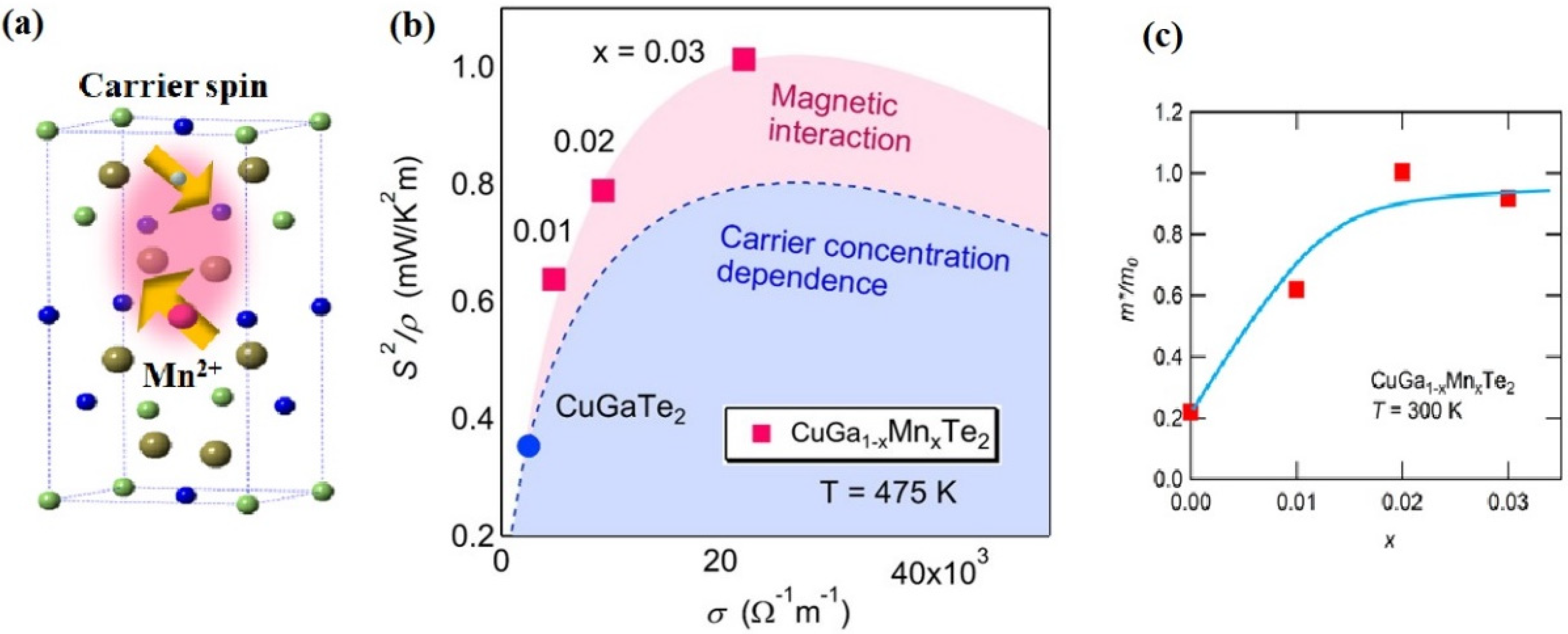
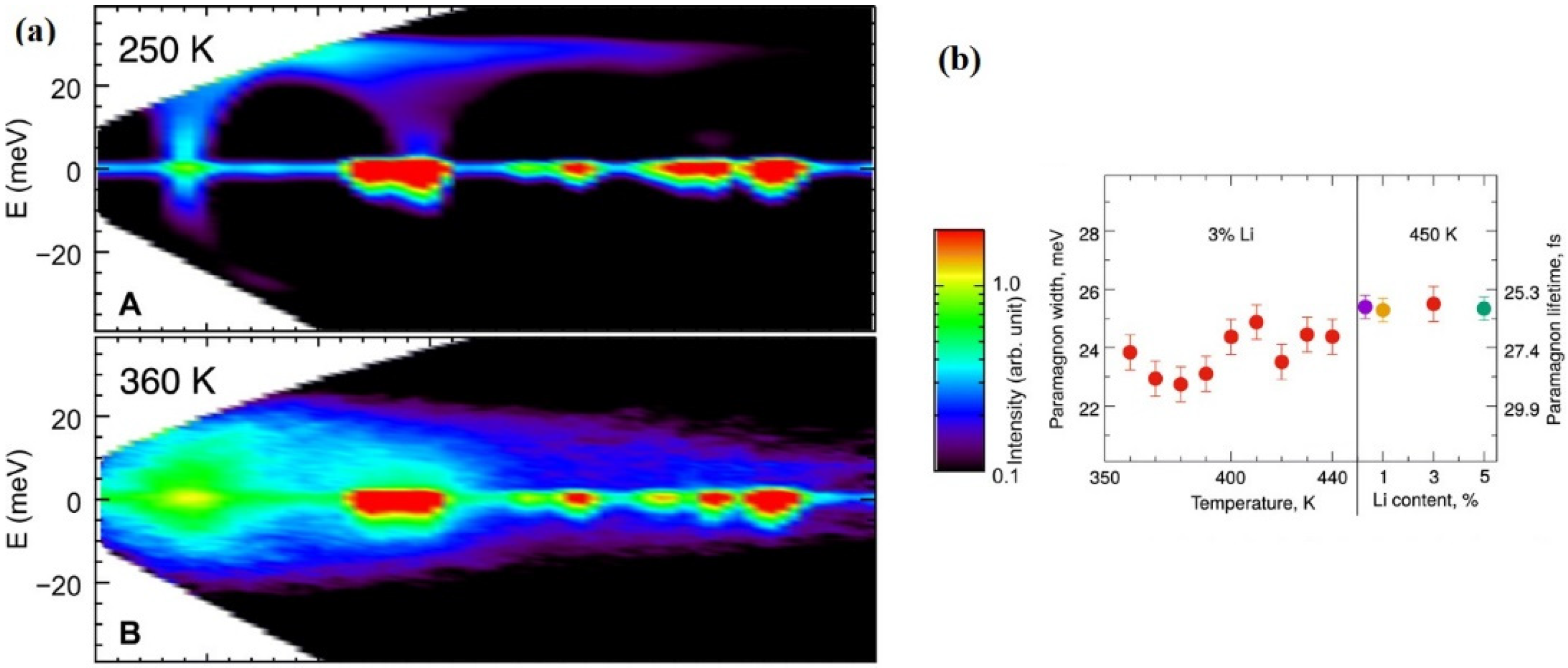
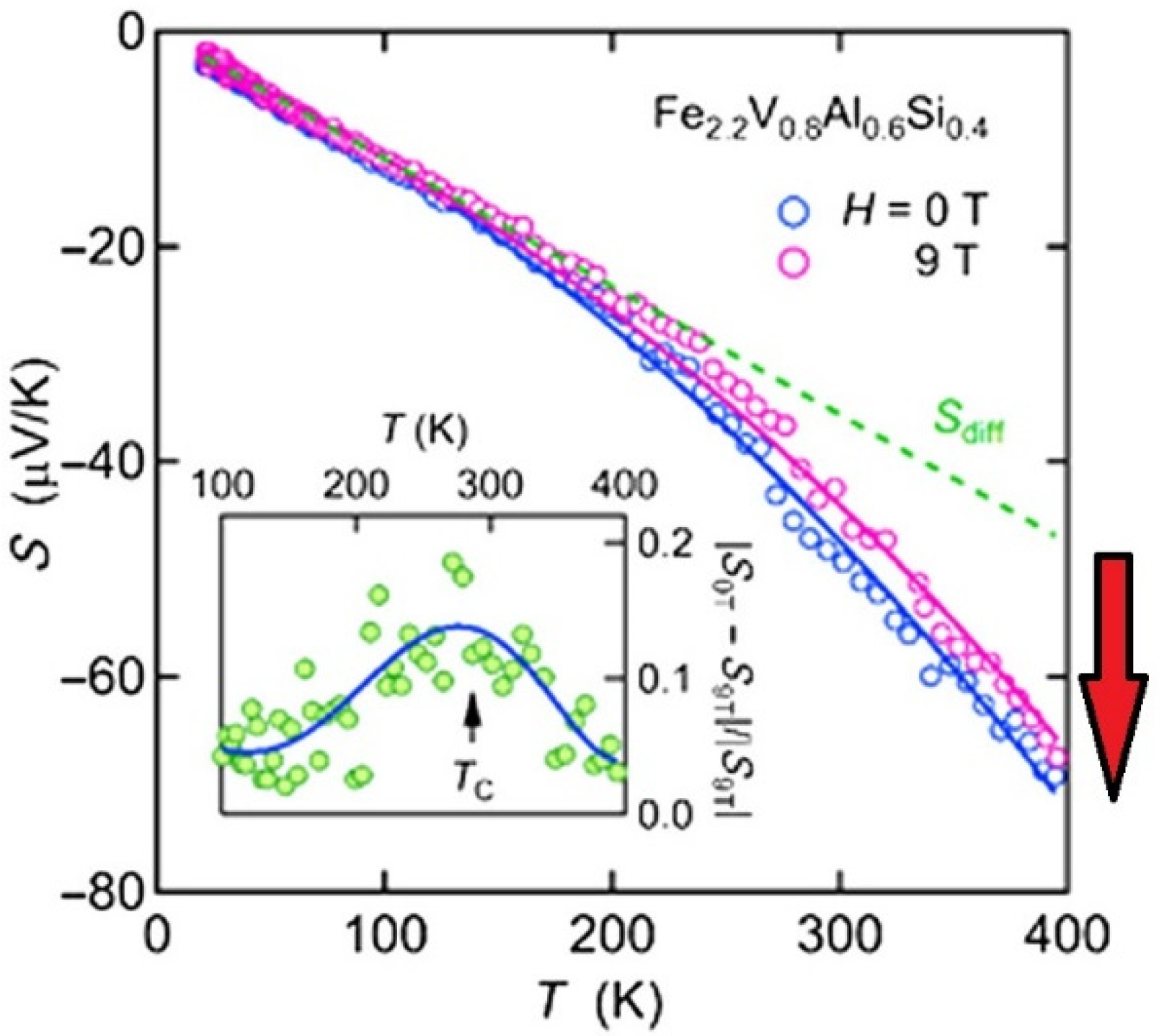

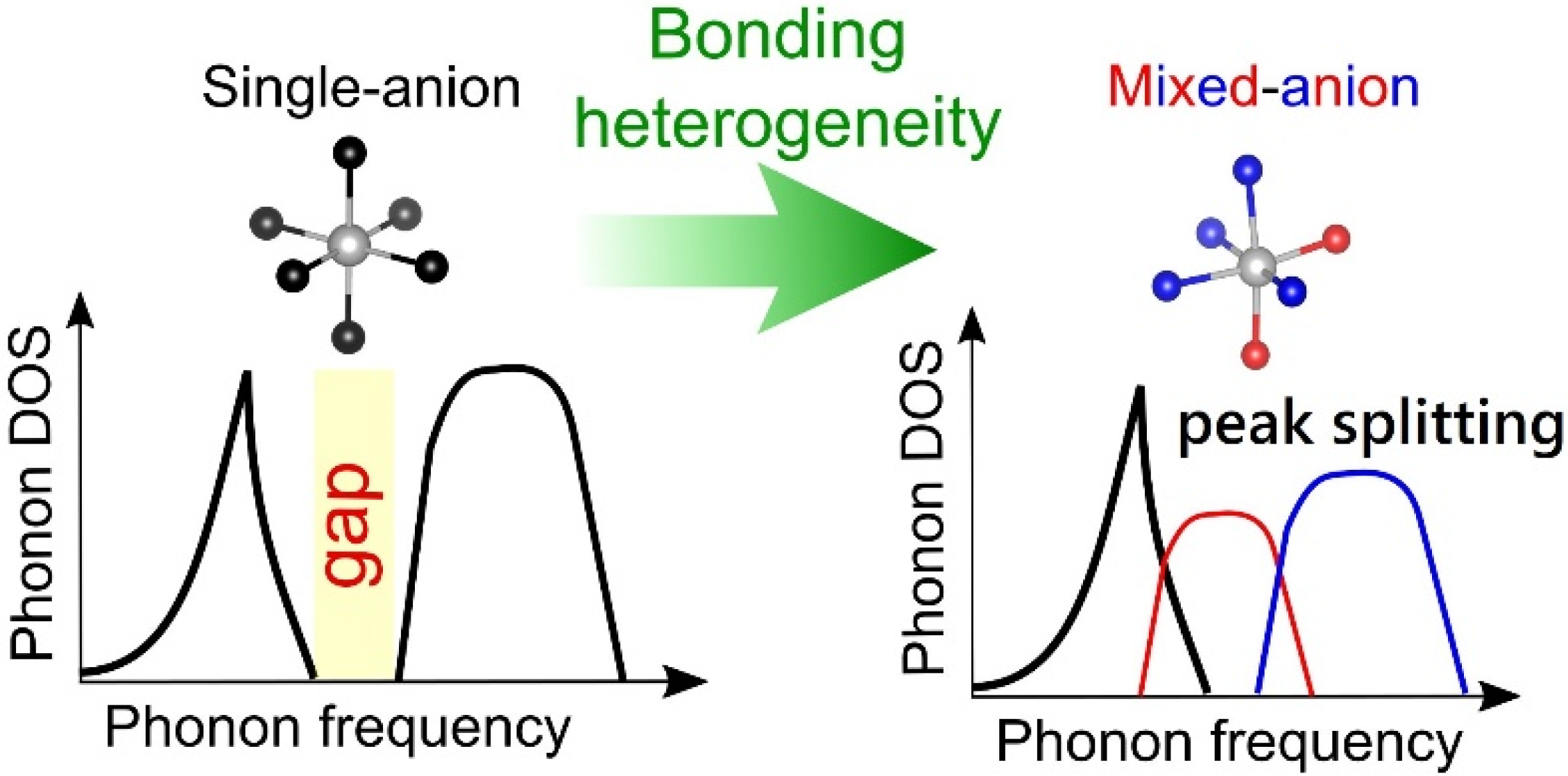
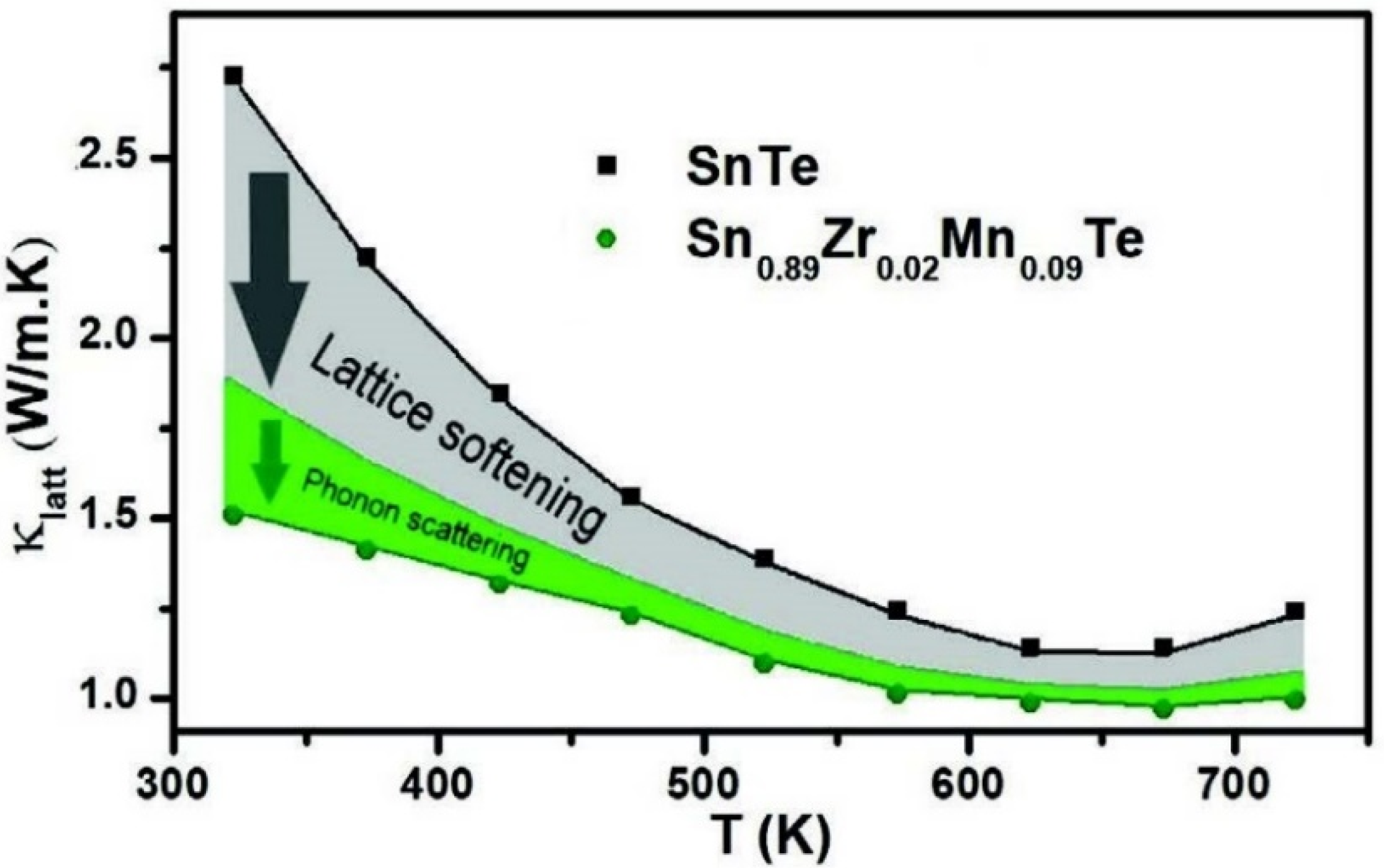




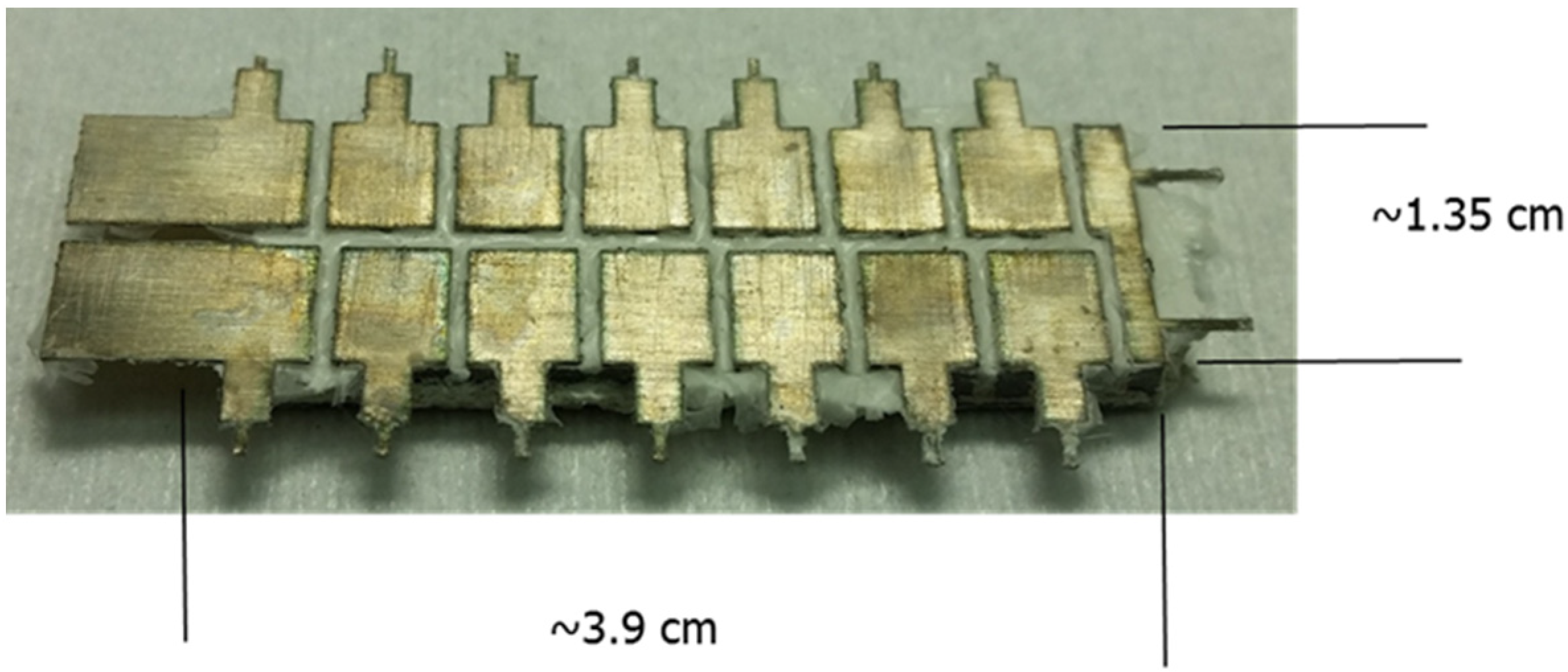
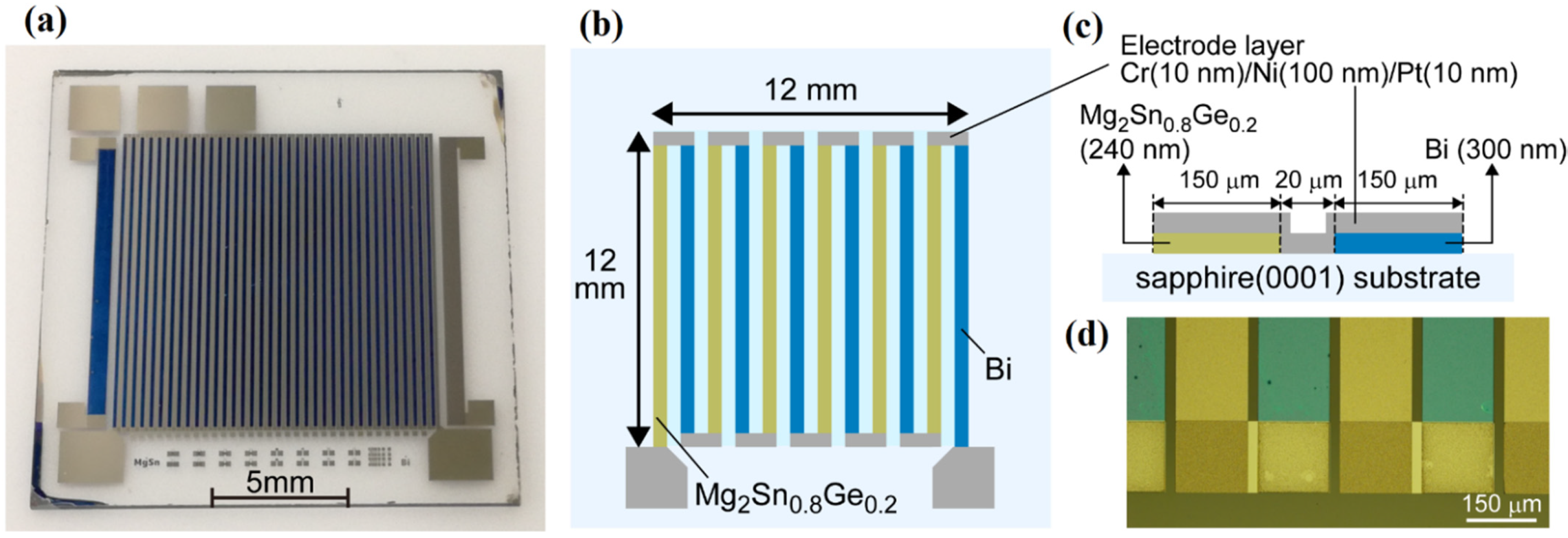
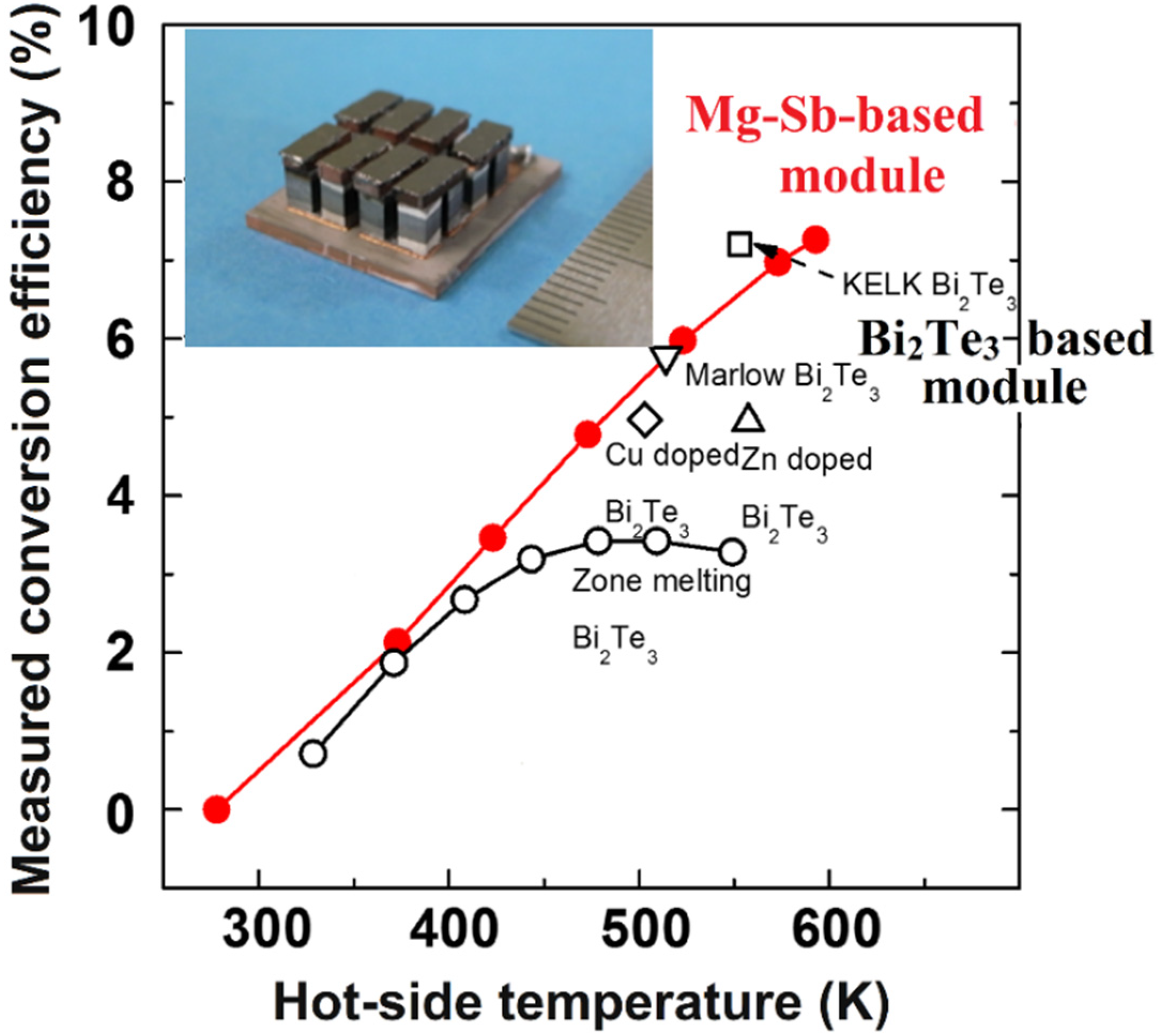

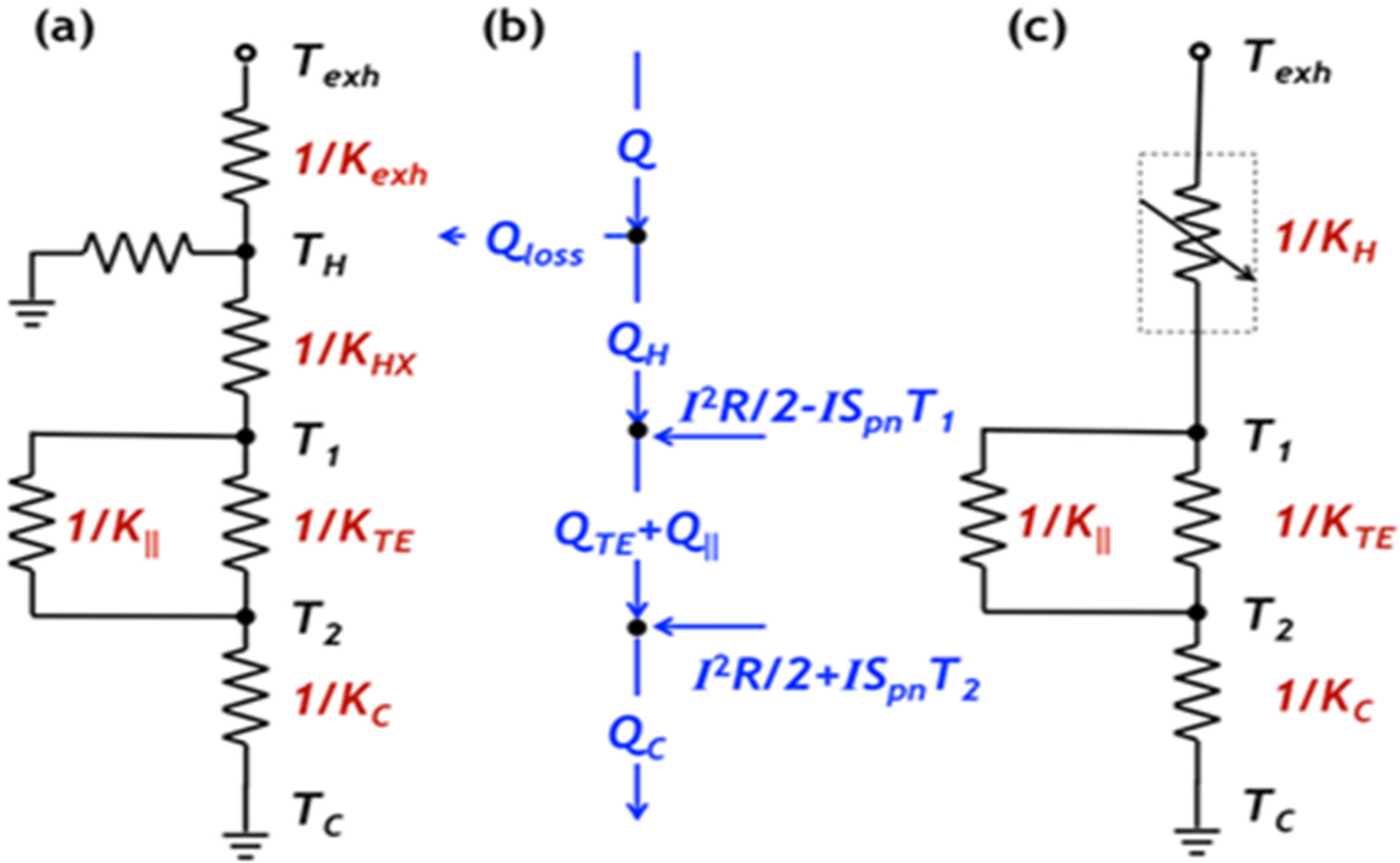
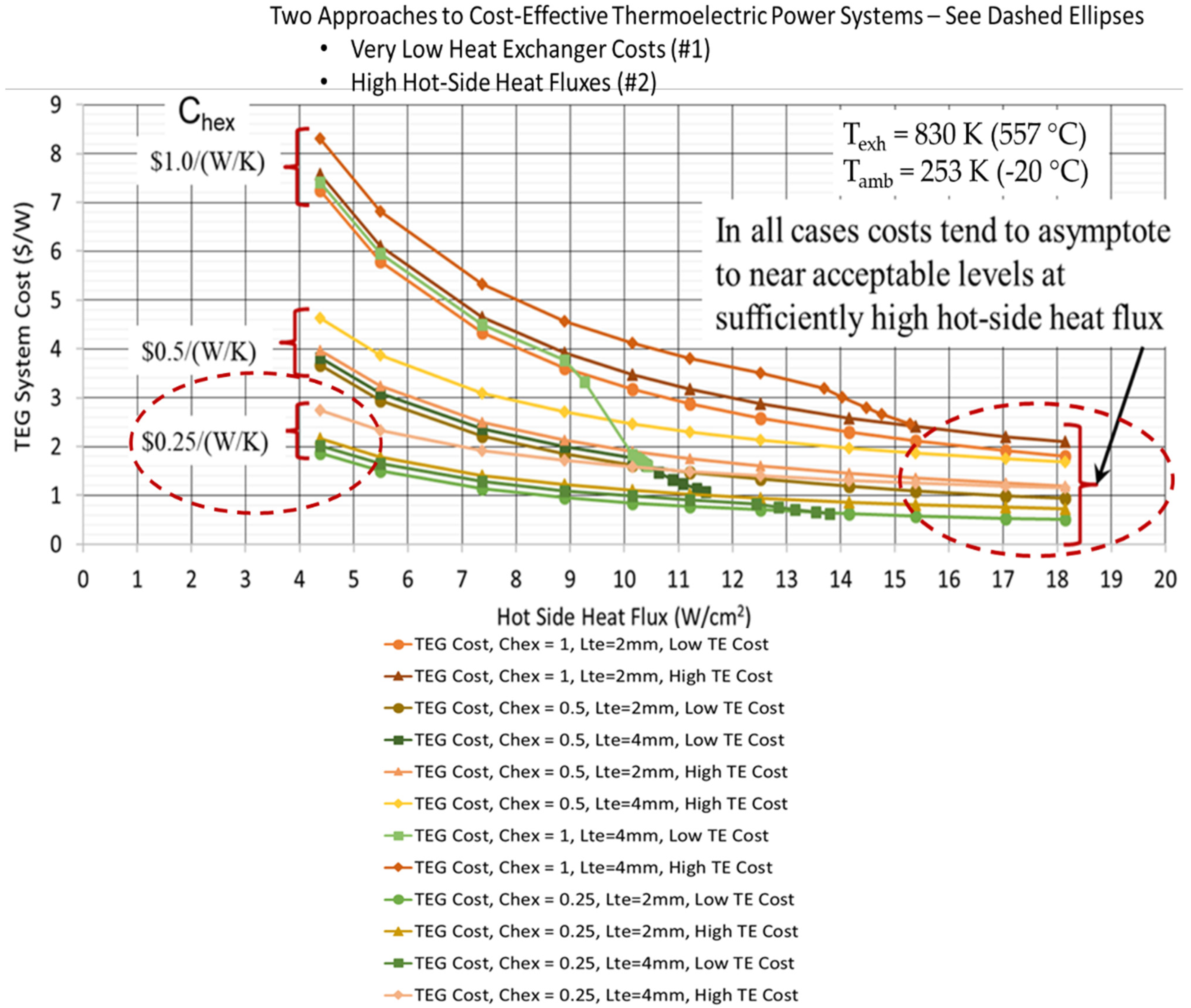
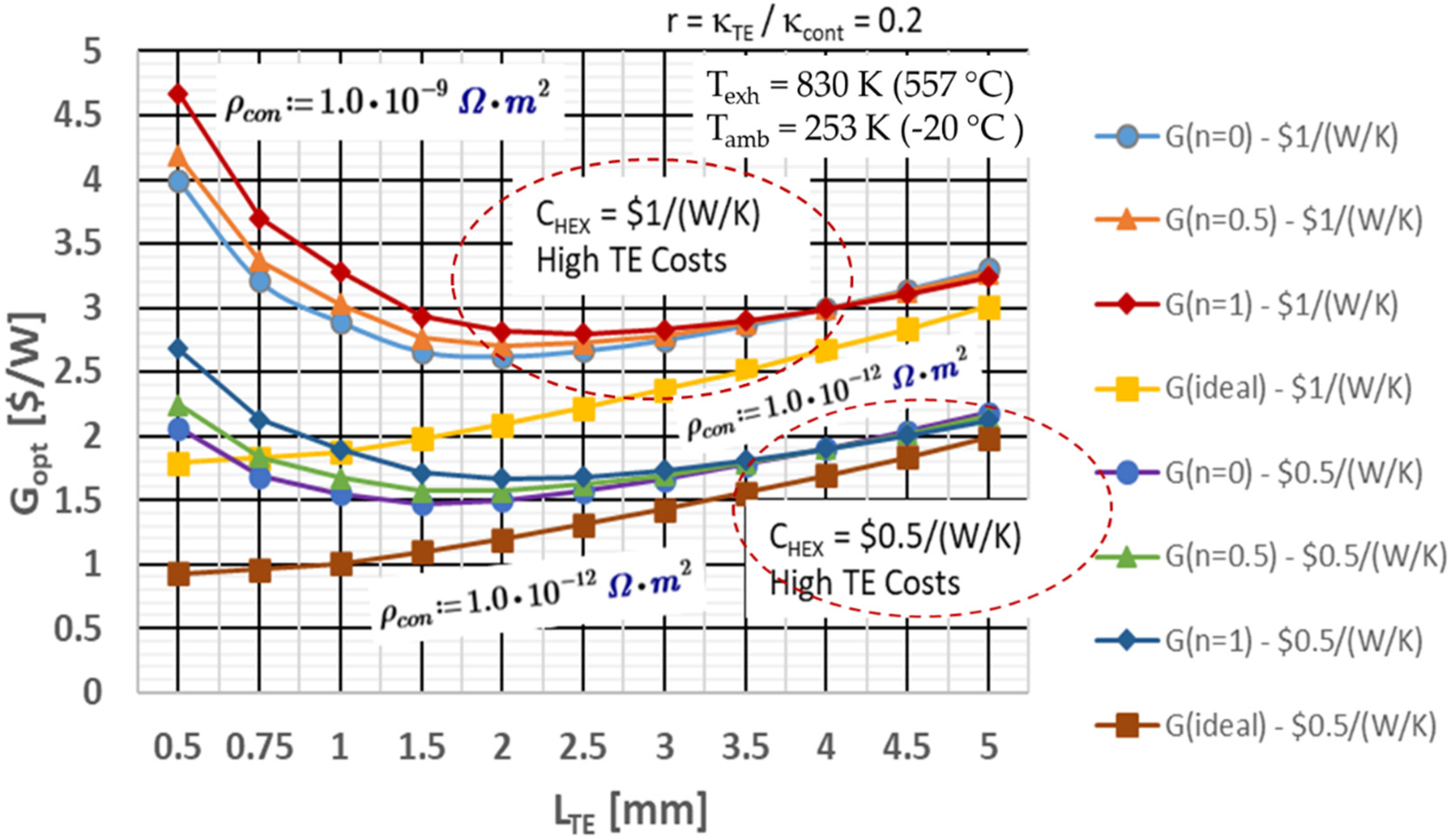
Publisher’s Note: MDPI stays neutral with regard to jurisdictional claims in published maps and institutional affiliations. |
© 2022 by the authors. Licensee MDPI, Basel, Switzerland. This article is an open access article distributed under the terms and conditions of the Creative Commons Attribution (CC BY) license (https://creativecommons.org/licenses/by/4.0/).
Share and Cite
Hendricks, T.; Caillat, T.; Mori, T. Keynote Review of Latest Advances in Thermoelectric Generation Materials, Devices, and Technologies 2022. Energies 2022, 15, 7307. https://doi.org/10.3390/en15197307
Hendricks T, Caillat T, Mori T. Keynote Review of Latest Advances in Thermoelectric Generation Materials, Devices, and Technologies 2022. Energies. 2022; 15(19):7307. https://doi.org/10.3390/en15197307
Chicago/Turabian StyleHendricks, Terry, Thierry Caillat, and Takao Mori. 2022. "Keynote Review of Latest Advances in Thermoelectric Generation Materials, Devices, and Technologies 2022" Energies 15, no. 19: 7307. https://doi.org/10.3390/en15197307
APA StyleHendricks, T., Caillat, T., & Mori, T. (2022). Keynote Review of Latest Advances in Thermoelectric Generation Materials, Devices, and Technologies 2022. Energies, 15(19), 7307. https://doi.org/10.3390/en15197307







